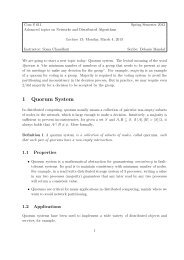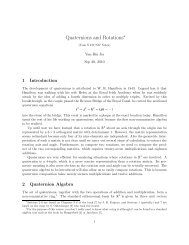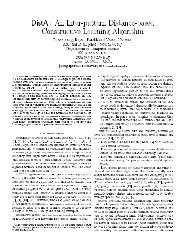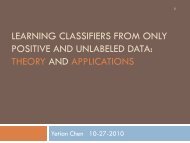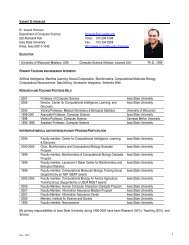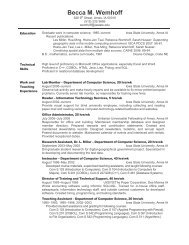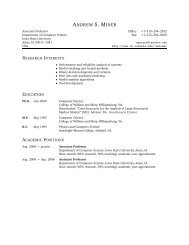Introduction
Introduction
Introduction
You also want an ePaper? Increase the reach of your titles
YUMPU automatically turns print PDFs into web optimized ePapers that Google loves.
CS 342 Lecture 1 <strong>Introduction</strong> to Com S 342 By: Hridesh Rajan<br />
WELCOME TO<br />
Computer Science 342<br />
PRINCIPLES OF PROGRAMMING LANGUAGES<br />
Professor : Hridesh Rajan<br />
Office : 101 Atanasoff Hall<br />
Phone : 294-6168<br />
Email : hridesh@cs.iastate.edu or<br />
cs342s@cs.iastate.edu<br />
Office Hours : Monday 3:40 - 5:00pm and by appointment<br />
TA : Youssef Hanna<br />
Office : 0145 Pearson Hall<br />
Email : ywhanna@cs.iastate.edu<br />
TA Office Hours : Tuesday and Thursday 1:00 - 2:00pm<br />
Course URL: : http://www.cs.iastate.edu/~cs342/<br />
1 INITIAL INSTRUCTIONS<br />
• From the course web page, go and read the following pages:<br />
– About Com S 342<br />
– Homework followed by hw0<br />
– Grading Policy<br />
– Contacting Us<br />
• Read the forward and the preface of the recommended textbook “Structure and Interpretation of<br />
Computer Programs” (SICP). This book is available on-line.<br />
• Start reading the Little Schemer, chapters 1-4.<br />
1
2 PROGRAMMING LANGUAGE<br />
Definition 2.1 A programming language is a language that is capable of expressing all computations.<br />
For example, Scheme and C++ are programming languages.<br />
Exercise 2.1<br />
What are other programming languages?<br />
Definition 2.2 A general-purpose langauge is one that is not tailored to some particular application area.<br />
Examples: AspectJ, Eos, Ruby, Python, Java, Ada, PL/I, BASIC, COBOL, Pascal, Ptolemy, SNOBOL,<br />
Icon, Algol W, Algol 60, Algol 68, C, Haskall, Edison, ... (literally thousands)<br />
But the techniques we’ll study aren’t just limited to general-purpose programming langauges.<br />
Definition 2.3 A special-purpose language is a language that is designed to support some particular application.<br />
These don’t have to be able to compute all computable functions.<br />
Examples: Lotus 1-2-3 macros, the MFC class library, MUMPS, JavaScript, VBA, Cold Fusion<br />
Exercise 2.2<br />
What are other formal languages?<br />
Formal languages are also used in a variety of settings: music, knitting, mathematics, engineering, ...<br />
3 THE COURSE IN A NUTSHELL<br />
• The journey to the mountain:<br />
– functional programming techniques<br />
• The mountain climb:<br />
– using functional techniques to write interpreters<br />
• Our equipment:<br />
– Scheme, a Lisp dialect<br />
• Our guides:<br />
– the textbook authors<br />
4 Com S 342 ESSENTIAL OBJECTIVES<br />
You should be able to:<br />
1. Write and modify programs in functional style<br />
2. Make effective use of data abstraction<br />
2
3. Change or enhance interpreters to have features such as:<br />
(a) control flow,<br />
(b) variables,<br />
(c) recursion,<br />
(d) scoping,<br />
(e) syntactic sugars,<br />
(f) arrays,<br />
(g) parameter passing mechanisms,<br />
(h) type checking,<br />
(i) objects, and inheritance<br />
4. Write programs using such features and explain their behavior<br />
5. Explain the data structures and algorithms used in interpreters.<br />
6. Compare alternatives in design and implementation.<br />
these are the essential ideas in programming languages.<br />
4.1 What is functional style?<br />
Use functions as arguments etc. to help modularize your code<br />
4.2 Why these objectives?<br />
• help you think about good ways to program, abstraction mechanisms<br />
• (see below for functional style)<br />
• data abstraction is key to making programs easily modifiable<br />
• learn new languages quickly mapping ideas from this class to the language<br />
• read/write language reference manual<br />
• help you program more effectively<br />
• most programs evolve into languages, or have language parts<br />
5 REASONS FOR USING FUNCTIONAL STYLE<br />
• Makes certain programs clearer<br />
– can see all inputs eval (exp, env)<br />
• functions as arguments helps in:<br />
– abstraction<br />
– modularization<br />
• gives you more ways to solve problems<br />
3
• ideas important for:<br />
– writing concurrent programs<br />
– algorithm design<br />
– specification<br />
– describing programming languages<br />
– web services<br />
• it’s interesting and fun<br />
6 SKILLS WE TEACH IN 342<br />
• functional abstraction techniques<br />
• data abstraction<br />
• how to build interpreters<br />
• meta-linguistic abstraction<br />
7 PREREQUISITES<br />
We intend to enforce the following formal prerequisites as best we can, if you don’t have these, drop this<br />
course.<br />
• Com S 321<br />
• Engl 104<br />
• Com S 330 or Cpr E 310<br />
• Com S 309 or Com S 361 or Com S 363<br />
For example, consider the following ideas that will be helpful during the course of this semester.<br />
Q: In what course do you learn about the halting problem?<br />
Q: Context-free grammars? Data abstraction?<br />
Q: Machine representation of data? The run-time stack?<br />
Q: Recursion?<br />
8 ESTIMATED TIME NEEDED FOR HOMEWORK<br />
Think of Com S 342 as like a math course. There are frequent problems to do and we go fast. The following<br />
is a rough estimate of necessary efforts.<br />
• Average: about 12 hrs/week.<br />
• Mode: about 13.5 hrs/week.<br />
• Range: 0-5 to more than 14 hrs/week.<br />
4
9 TEXTBOOKS<br />
9.1 Required<br />
• Essentials of Programming Languages (3rd edition) [3]<br />
• The Little Schemer (4th edition) [2]<br />
9.2 Recommended<br />
• Structure and Interpretation of Computer Programs (2nd edition) [1]<br />
Also there is stuff on reserve and on the web<br />
10 GRADING<br />
• No curve grading<br />
• Your grade is<br />
– 70% based on tests<br />
– 30% on homework<br />
Moral: use homeworks to learn, cheating on homework won’t help<br />
Other policies such as those for late homework, exams, etc, are described on the course web page<br />
Exercise 10.3<br />
In groups of 3 (or 4) for 5 minutes:<br />
1. introduce yourselves<br />
2. write down at least 1 question about the policies, course specification, or syllabus that you agree is<br />
confusing or you want to talk about<br />
3. select someone to ask the question(s)<br />
5
Com S 342 Policy/Review Quiz By: Hridesh Rajan<br />
This quiz is not worth any points but solely for your review and to help you realize when you don’t<br />
understand something from class. Following answers could be either true or false.<br />
1. This course is graded on an absolute grading scale (i.e. there will be no curve).<br />
2. Extra credit points are applied at the end of the course to my total homework score to determine my<br />
final grade.<br />
3. If I do poorly on the exercises, I will only lose the points for exercises - it will not be considered<br />
subjectively in the final grade (beyond its 5% contribution).<br />
4. If I do poorly on the homeworks, I will only lose the points for homeworks - it will not be considered<br />
subjectively in the final grade (beyond its 30% contribution).<br />
5. Instructional staff can meet with you outside of office hours by appointment.<br />
6. This course has an online form for anonymous feedback.<br />
7. Lecture attendance is required. Recitation attendance is not.<br />
8. Lecture outlines are posted on the course web site.<br />
9. If you cannot understand what the professor is saying, the proper response is to just be quiet and look<br />
it up later because everyone else understands.<br />
10. The main reason to learn Scheme (even if you hate it) is because it’s used everywhere in business so<br />
you won’t be able to avoid it.<br />
Following are short answer questions.<br />
11. The e-mail address to write to for quickest reply from the instructional staff is:<br />
12. You should check your department Unix account at least how often for course information?<br />
13. According to Prof. Rajan, the number one thing to remember about Scheme is that:<br />
Write most important point, what you’d like to hear more about in 2 minutes (if time) (give it to me)<br />
References<br />
[1] H. Abelson, G. Sussman, and J. Sussman. Structure and Interpretation of Computer Programs.<br />
McGraw-Hill Higher Education, 1996.<br />
[2] D. P. Friedman and M. Felleisen. The little Schemer (4th ed.). MIT Press, Cambridge, MA, USA, 1996.<br />
[3] D. P. Friedman and M. Wand. Essentials of Programming Languages, 3rd Edition. The MIT Press,<br />
2008.<br />
6



